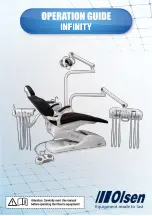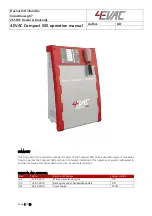
2
08.02
TO.1000.M.
-
-
-
-
OPERATION AND MAINTENANCE
BETRIEBS- UND WARTUNGSANLEITUNG
UTILISATION ET ENTRETIEN
USO E MANUTENZIONE
DCC•DVC
39
M) CHECK-LIST IN CASO DI GUA-
STO
DOMANDE GENERALI
a) L’utensile di dosaggio parte senza
problemi anche dopo lunghi periodi
di sosta?
b) Pare che le condizioni atmosferiche
contribuiscano al malfunzionamen-
to?
c) La macchina deve lavorare in modo
perfettamente orizzontale.
d) La bocca di scarico deve essere li-
bera.
CONTROLLO DELLA
TRAMOGGIA
a) La tramoggia deve essere inferiore
a 100 litri.
b) La tramoggia è equipaggiata con un
deflettore rompiponte?
c) La tramoggia è equipaggiata con un
impianto di fluidificazione, di un vi-
bratore o martellatore?
CONTROLLO MOTORE
ELETTRICO
a) Sono possibili sbalzi di corrente di
alimentazione a causa dell’avvia-
mento contemporaneo di diverse
macchine?
b) L’impianto è equipaggiato con un ge-
neratore di corrente?
c) Controllare se il motore riceve cor-
rente!
d) Controllare se il motore è collegato
correttamente e se i fili sono fissati
bene ai morsetti!
e) Controllare la regolazione della ter-
mica del motore nel quadro genera-
le e confrontarla con i dati sulla tar-
ghetta del motore!
f)
Verificare il giusto senso di rotazio-
ne del motore elettrico!
g) Verificare se la sezione dei cavi di
alimentazione è idonea alla potenza
installata.
CONTROLLO DEL MICRODOSATO-
R E
a) Il materiale si è attaccato all’elica di
dosaggio?
b) Ci sono dei blocchi di materiale che
ostruiscono il trasporto?
c) Il corpo in poliuretano si è rovinato?
d) Accertarsi che le tenute non perda-
no materiale.
e) Durante il trasporto l’elica non deve
toccare il tubo di scarico.
CONTROLLO DEL PRODOTTO
a) denominazione del prodotto ?
b) densità? (kg/dm
3
)
c) granulometria ? (µm/mm)
d) umidità? (%)
e) scorrevolezza? (fare scorrere il ma-
teriale su una lamiera aumentando
lentamente l’inclinazione!)
f ) comprimibilità ‘ (è possibile fare una
“palla di neve”?)
g) abrasività? (fa male quando si sfre-
ga il prodotto tra le dita?)
4) Controllo parte meccanica
a) Funziona il tappo di sfiato del ridutto-
re?
b) Assicurarsi che la bocca di scarico sia
libera di incrostazioni che riducono la
sezione della stessa bocca. Descri-
vere la situazione della bocca di sca-
rico.
c) Verificare il livello dell’olio nel ri-
duttore
d) controllare lo stato dei cuscinetti,
se usurati o grippati, sostituirli.
M) CHECK LIST IN CASE OF
TROUBLE
GENERAL QUESTIONS
a) Does metering screw start without
problems even after longer down
periods?
b) Does it seem that atmospheric con-
ditions contribute to malfunctioning?
c) Feeder must work in perfectly hor-
izontal position.
d) Outlet must be free.
HOPPER CHECK
a) Hopper capacity must be less
than 100 litres.
b) Is hopper equipped with bridge
breaking deflector?
c) Is hopper equipped with fluidiza-
tion, vibrator or knocker?
ELECTRIC MOTOR CHECK
a) Are voltage drops possible due
to contemperary starting of dif-
ferent machines?
b) Is the plant equipped with a power
generator ?
c) Check if motor receives power.
d) Check motor is correctly connect-
ed and wires are fixed properly to
terminals.
e) Check power cut-out in main con-
trols is correctly set and compare
to motor plate data.
f)
Check correct sense of rotation of
electric motor.
MICRO-BATCH FEEDER CHECK
a) Does material stick to metering
screw?
b) Are there any lumps of material hin-
dering material transport?
c) Is the polyurethane body dam-
aged?
d) Ensure shaft seals do not loose
material.
e) During transport metering screw
must not touch feeder pipe.
MATERIAL CHECK
a) Material description?
b) Bulk density? (kg/dm
3
)
c) Particle size? (µm/mm)
d) Humidity? (%)
e) Flowability? (make material slide
down a metal plate by varying the
angle from low to steep)
f)
Compressible material? (can you
make a “snowball”?)
g) Abrasive material? (does it hurt
when rubbing it between fingers?)
4) Mechanical parts check
a) Is breather plug of gear reducer
working okay?
b) Check outlet is free of crusts.
Describe outlet
c) Check the oil level in the gear
reducer.
d) Check the bearings, and replace
if they are worn or seized.
M) CHECKLISTE BEI
BETRIEBSSTÖRUNGEN
ALLGEMEINE FRAGEN
a) Läuft Dosierwerkzeug auch nach
längeren Betriebsunterbrechun-
gen problemlos an?
b) Scheint Fehlfunktion durch Wit-
terung begünstigt ?
c) Gerät muß sich in exakt horizon-
taler Lage befinden.
d) Auslauf muß frei sein.
KONTROLLE DES TRICHTERS
a) Trichterinhalt muß weniger als
100 l betragen.
b) Ist Trichter mit Entlastungsvor-
richtung ausgestattet?
c) Ist Trichter mit Luftauflocke-
rung, Rüttler oder Klopfer aus-
gestattet?
KONTROLLE E-MOTOR
a) Sind aufgrund gleichzeitigen Ein-
schaltens mehrerer Geräte Span-
nungsschwankungen möglich?
b) Ist Anlage mit einem Stromge-
nerator ausgerüstet?
c) Prüfen, ob am Motor Strom an-
liegt.
d) Prüfen, ob Motor korrekt ange-
schlossen ist und ob Klemmenmut-
tern fest angezogen sind.
e) Prüfen, ob Überstromschalter
des Motors in der Hauptsteue-
rung richtig eingestellt ist und mit
Typenschilddaten vergleichen.
f )
Motordrehrichtung prüfen.
KONTROLLE DES MIKRO-DOSIE-
RERS
a) Haftet Dosiergut am Dosier-
werkzeug?
b) Behindern Produktklumpen die
Dosierung?
c) Ist der Polyurethankörper be-
schädigt?
d) Sicherstellen, daß durch die Wel-
lenabdichtungen kein Produkt
austritt.
e) Während der Dosierung darf das
Dosierwerkzeug das Förderrohr
nicht berühren.
PRÜFUNG DES DOSIERGUTS
a) Materialbezeichnung?
b) Schüttgewicht? (kg/dm
3
)
c) Körnung? (µm/mm)
d) Feuchte? (%)
e) Fließfähigkeit ? (Materialprobe
auf einem geneigten Blech zum
Fließen bringen)
f )
Komprimierbarkeit? (Kann ein
“Schneeball” geformt wer-den?)
g) Abrasivität? (Schmerzt es, wenn
man Material zwischen den Fin-
gern reibt?)
4) Kontrolle der mechanischen
Teile
a) Sind Getriebe-Entlüftungsschrau-
ben funktionstüchtig?
b) Prüfen, ob Auslauf frei von Ver-
krustungen ist. Auslaufsituation
aufnehmen bzw. beschreiben.
c) Den Ölstand im Getriebe prüfen.
d) Den Lagerzustand prüfen. Ggf.
ersetzen, wenn sie verschlissen
oder festgefressen sind.
M) CHECK-LIST EN CAS DE VIS
EN PANNE
DEMANDES GENERALES
a) L’outil de dosage démarre sans pro-
blèmes même après des longues
périodes d’inactivité?
b) Il semble que les conditions atmos-
phériques contribuisent au malfonc-
tionnement?
c) Il faut que le doseur travaille de
manière parfaitement horizontale.
d) Il faut que la bouche de sortie soit
libre.
CONTROLE DE LA TREMIE
a) La trémie doit être plus petite que
100 litres.
b) La trémie est équipée d’un déflec-
teur casse-voûte?
c) La trémie est équipée d’un système
de fluidification, d’un vibrateur ou
d’un percuteur?
CONTROLE MOTEUR ELECTRI-
QUE
a) Est-ce qu’il y a la possibilité de va-
riations de courant d’alimentation à
cause d’un démarrage de divers ap-
pareils au même temps?
b) L’installation est équipée d’un gé-
nérateur de courant?
c) Contrôler si le moteur reçoit du cou-
rant!
d) Contrôler si le moteur est connecté
correctement et si les fils sont fixés
bien aux bornes.
e) Contrôler le réglage thermique du
moteur dans le pupitre général et
le confronter avec les données sur
la plaque du moteur.
f)
Verificare il giusto senso di rotazione
del motore elettrico!
CONTROLE DU MICRODOSEUR
a) Le matériau a adhéré à l’outil de
dosage?
b) Est-ce qu’il y a des blocs de maté-
riau qui obstruisent le dosage?
c) Est-ce que le corps en polyurétha-
ne est ruiné?
d) S’assurer que les joints d’étanchéi-
té ne perdent pas de matériau.
e) Durant le transport l’outil de dosa-
ge ne doit pas toucher le tube de
décharge.
CONTROLE DU MATERIAU
a) Désignation du matériau
b) Densité? (kg/dm
3
)
c)
Granulométrie? (µm/mm)
d) Humidité? (%)
e) Fluidité? (faites couler le matériau sur
une tôle en augmentant l’inclinaison de
la même)
f)
Compressibilité? (est-il possible de
faire une “boule de neige”?)
g) Abrasivité? (est ce qu’il fait mal quand
on frotte le matériau dans les
doigts?)
4) Contrôle des composants mé-
caniques
a) Est ce que l’évent du réducteur fonc-
tionne?
b) Contrôler si la bouche de décharge
de la vis est libre. Décriver la situa-
tion de la bouche.
c) Vérifier le niveau de l’huile dans
le réducteur
d) contrôler l’état des roulements;
s’ils sont usés ou grippés, les
remplacer.









































